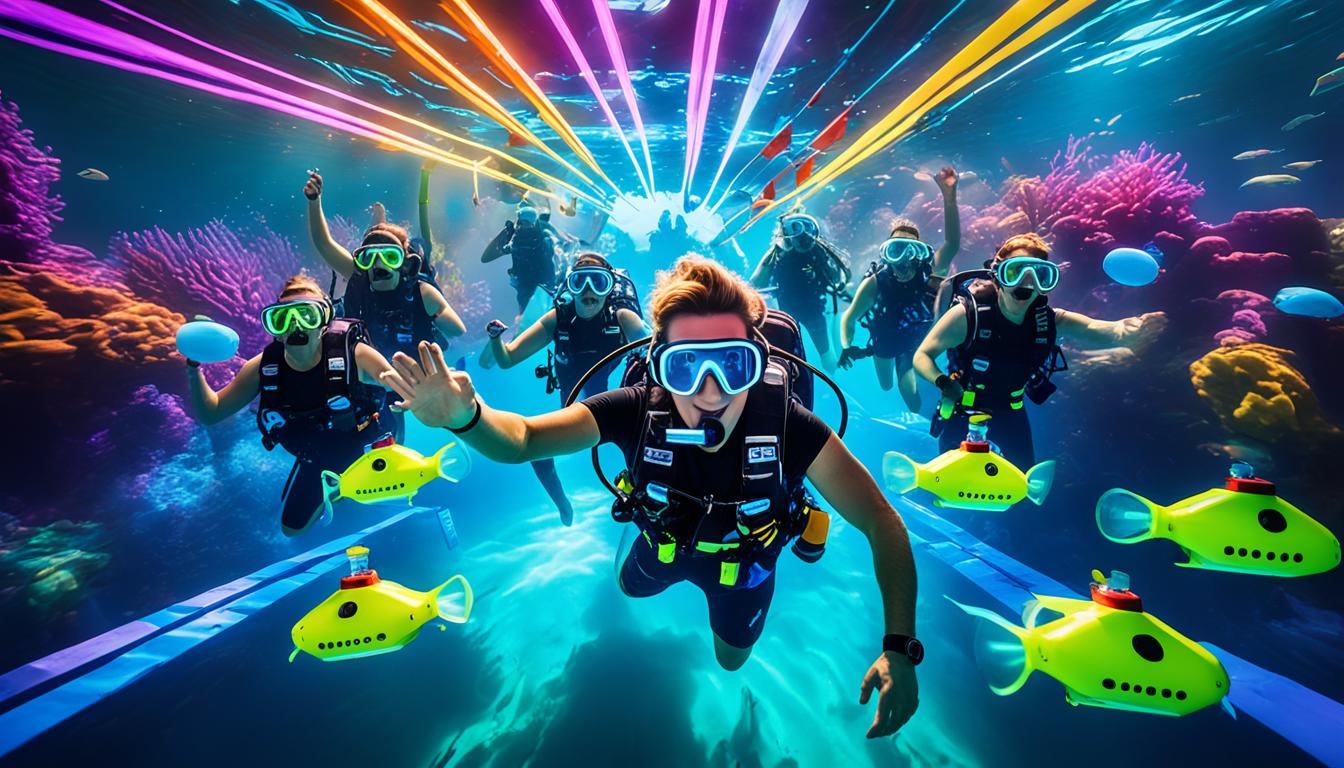- Underwater drones enable stunning photography and videography previously only accessible to professionals.
- Key features for drones include camera quality, lighting options, depth capability, and battery life.
- Proper lighting is crucial for underwater imaging to counteract color loss at depth.
- Understanding and following local regulations is essential for responsible drone use.
- Post-processing can significantly enhance the quality of underwater footage.
Imagine submerging into the tranquil world beneath the waves, your drone gliding alongside colorful fish and intricate coral reefs. Underwater photography and videography with drones are not just about capturing images; it’s about sharing the marvels of an aquatic realm that many will never get to see firsthand. Let’s dive into the depths and explore how to bring these wonders into the light.
Unlock the Depths: Tips for Using Waterproof LED Lights
Lighting is the secret sauce of underwater imagery. As you descend, colors like red and orange quickly fade, leaving your footage looking blue and lifeless. But with the right LED lights, you can bring the true colors of the underwater world to life.
Choosing the Right LED Lights for Clarity and Color
When selecting LED lights for your drone, consider their brightness, usually measured in lumens. A light ranging from 1000 to 3000 lumens should suffice for clear visibility. But it’s not just about brightness; the color temperature is equally important. Look for lights with a color temperature around 5000 to 6500 Kelvin to mimic natural sunlight underwater.
Best Practices for Positioning Lights on Your Drone
Positioning your lights effectively can make or break your underwater scenes. Here’s how to do it right:
- Mount the lights on the sides of your drone to reduce shadows and backscatter.
- Adjust the angle of the lights to prevent them from pointing directly at your subject, which can cause overexposure.
- Use diffusers on your lights to soften the light and reduce harsh contrasts.
Expanding Your View: External Camera Mounts Explained
While many underwater drones come with built-in cameras, sometimes you need that extra oomph in image quality or a different perspective. That’s where external camera mounts come into play, allowing you to attach additional cameras to your drone for enhanced flexibility.
Different Types of Mounts and Their Uses
There are several mount options available, each serving a different purpose:
- Ball mounts: Offer a secure grip and easy adjustability for various angles.
- Tray mounts: Ideal for mounting multiple accessories, including lights and cameras.
- Clamp mounts: Provide a firm hold and are perfect for quick setup and adjustments.
Step-by-Step Guide to Attaching Your Camera Securely
Securing your camera is paramount to avoid losing it in the depths:
- Choose a mount compatible with both your drone and camera.
- Ensure all screws and clamps are tightened and check for any signs of wear or damage.
- Test the setup in shallow water to ensure the camera is secure and the footage is stable.
Now, with your lights set and camera mounted, you’re ready to capture the underwater world in all its glory. But there’s more to explore, so let’s keep diving deeper.
Deep Sea Vision: Selecting Underwater Cameras and Housings
Whether you’re capturing the dance of a school of fish or the silent stillness of a shipwreck, the right camera is essential. The market is teeming with options, but the key is to find a camera that can withstand the pressure of the deep while delivering high-quality images.
Key Features to Look for in Underwater Cameras
As you shop for that perfect underwater camera, here are some must-have features:
- High resolution: For crisp, clear images, aim for a camera with at least 12 megapixels.
- Manual controls: The ability to adjust settings like exposure and focus is crucial in the dynamic underwater environment.
- Raw format support: Shooting in raw preserves all the data from your camera sensor, giving you more flexibility in post-processing.
Protecting Your Gear: The Importance of Proper Housing
Your camera’s housing is like a diving suit; it must be watertight and able to withstand the pressures of the deep. Ensure the housing is specifically designed for your camera model and check the depth rating to match your diving plans.
Immersive Footage with 360-Degree Cameras
Imagine being able to capture not just a frame, but the entire sphere of the underwater world. With 360-degree cameras, you can immerse viewers in a scene, allowing them to look around as if they were there with you.
How to Capture Full-Scale Panoramic Videos
When using a 360-degree camera, keep these tips in mind:
- Mount the camera on a stable platform to prevent shaky footage.
- Avoid getting too close to objects, as stitching lines can become more apparent.
- Be mindful of your own position to not accidentally become part of the scene unless intended.
Editing Tips for 360-Degree Underwater Footage
Editing 360-degree video is a bit different than traditional footage. Use specialized software that can handle the stitching process and consider the viewer’s perspective when making cuts and adding effects.
Long-Lasting Adventures: Extended Battery Packs
The last thing you want is for your drone to run out of juice in the middle of a mesmerizing dive. Extended battery packs can give you the extra time you need to explore and capture those unforgettable shots.
Finding the Right Balance between Size and Battery Life
When choosing a battery pack, consider both the size and the capacity. A larger battery can provide more power, but it also adds weight and may affect your drone’s buoyancy and maneuverability.
Maintaining and Charging Your Batteries Safely
Always follow the manufacturer’s instructions for charging and storing your batteries. Use a high-quality charger and never leave batteries unattended while charging. Remember, safety first!
Navigating the Unknown: Utilizing Sonar Systems
Sonar systems can be your eyes in the murky depths where visibility is low. They use sound waves to map out the ocean floor, helping you avoid obstacles and find interesting subjects to photograph.
The Basics of Sonar Technology in Underwater Exploration
Sonar works by emitting sound pulses and measuring the time it takes for the echoes to return. This data creates a picture of the underwater environment, which can be invaluable for navigation and composition.
Interpreting Sonar Data for Improved Photography Opportunities
Learn to read sonar data to identify potential photography subjects. Look for unusual shapes or structures that could be interesting to explore and capture with your camera.
Maintain Optimal Performance: Replacement Propellers
Propellers are the workhorses of your underwater drone, providing the thrust needed to navigate the currents. Over time, they can wear out or become damaged, which can affect your drone’s performance.
When and How to Replace Your Drone’s Propellers
Inspect your propellers regularly for nicks, cracks, or other signs of wear. If you notice any damage, or if your drone starts to handle oddly, it’s time to replace them. Always carry spare propellers with you on your dives.
Propeller Types and Their Impact on Underwater Movement
Propellers come in various shapes and sizes, each designed for different performance characteristics. For example, wider blades can provide more thrust but may also consume more battery power.
Enhancing Control: Remote Control Units
Mastering the controls of your underwater drone is like learning to play an instrument; it takes practice, but once you’ve got it, you’re creating art. The remote control unit is your direct link to your drone, your brush to paint the underwater canvas.
Choosing the Right Remote for Your Underwater Drone
When selecting a remote control unit, look for one with intuitive design and responsive controls. It should feel comfortable in your hands and provide feedback that helps you understand what the drone is doing, even when it’s out of sight.
Mastering the Controls: Tips for Precision and Accuracy
Here’s how to get the most out of your remote control:
- Practice in a controlled environment, like a swimming pool, to get a feel for the drone’s response to your commands.
- Use gentle movements to avoid sudden jerks that could disrupt your footage.
- Keep a steady hand and maintain focus on your drone’s movements to anticipate and counteract any unwanted drift.
Transporting Your Gear: Choosing the Right Carrying Cases
Adventures await, but first, you need to get your equipment there in one piece. A good carrying case is your gear’s first line of defense against the bumps and bruises of travel.
Features to Consider for Ultimate Protection
A robust carrying case should have:
- Hard exterior shell for impact resistance.
- Customizable foam inserts to snugly fit your drone and accessories.
- Waterproof and dustproof seals to keep the elements at bay.
Packing Your Drone and Accessories for Travel
When packing your drone, make sure everything has its place and is secured. Cushion your drone and accessories with foam padding to prevent movement, and always double-check that the case is sealed properly before you head out.
Mastering Tether Management Systems
Underwater drones are often connected to the surface by a tether, which transmits power and data. Managing this lifeline effectively is key to a smooth operation.
Setting Up Your Tether System for Uninterrupted Operation
To set up your tether system:
- Ensure there’s enough slack to allow free movement without putting stress on the connections.
- Avoid entanglements by keeping the tether clear of the propellers and any underwater structures.
- Use buoyancy aids along the tether to prevent it from dragging on the seabed.
Preventing Tangles and Ensuring Strong Signal Transmission
Tangles can disrupt communication and even damage your drone. Use a reel system to deploy and retrieve the tether smoothly, and regularly inspect it for any signs of wear or damage.
Underwater GPS Modules for Accurate Tracking
While traditional GPS signals don’t penetrate water well, specialized underwater GPS modules use sound waves to triangulate positions, guiding you back to specific sites or helping you map your explorations.
How GPS Works Underwater and Its Limitations
Underwater GPS systems work differently from above-water GPS. They require multiple transponders to create a positioning network. While they provide valuable data, they can be affected by water conditions and require careful calibration.
Integrating GPS Data with Your Photography Workflow
With GPS data, you can tag your photos and videos with precise location information. This is invaluable for scientific research, environmental monitoring, or simply for finding your way back to that perfect underwater scene.
Interacting with Aquatic Environments Using Robotic Arms
For those who want to interact with the underwater environment, robotic arms can be attached to drones. These allow for sample collection, object manipulation, and even interaction with marine life.
Applications of Robotic Arms in Underwater Research
Robotic arms are incredibly versatile and can be used for:
- Collecting samples of sediment or marine organisms.
- Placing or retrieving scientific instruments.
- Conducting surveys and inspections on underwater infrastructure.
Operational Tips for Precise Maneuvering and Sampling
Using robotic arms requires practice. Start with simple tasks and gradually work up to more complex operations. Always move slowly and deliberately to avoid disturbing the environment or your subject.
Buoyancy Control Devices for Perfect Stability
Just as divers use buoyancy control to glide effortlessly underwater, your drone needs proper buoyancy to maintain the desired depth and stability for that perfect shot.
Understanding Buoyancy in Underwater Drones
Buoyancy is the force that allows your drone to float or sink. It’s a delicate balance that depends on the drone’s weight, the water’s density, and the air or foam used to adjust buoyancy.
Adjusting Buoyancy for Different Underwater Conditions
Adjust your drone’s buoyancy before each dive based on the salinity of the water and the weight of any additional gear. Test in a controlled environment to ensure your drone neither sinks to the bottom nor floats uncontrollably to the surface.
Recording the Sounds of the Sea with Underwater Microphones (Hydrophones)
The underwater world is not silent. By using hydrophones, you can capture the symphony of the sea, from the clicks of dolphins to the rumble of a distant ship.
Techniques for Capturing Clear Underwater Audio
To capture clear audio:
- Position the hydrophone away from the drone’s motors to avoid interference.
- Use a windscreen to reduce noise from water movement.
- Record at a high bitrate to ensure the best sound quality.
Incorporating Sounds into Your Underwater Videos
Audio can add a whole new dimension to your underwater videos. When editing, balance the levels to ensure the sounds enhance, rather than overwhelm, the visual experience.
Protect Your Investment: Protective Skins and Wraps
Underwater drones face a corrosive saltwater environment that can take its toll on the equipment. Protective skins and wraps can help shield your drone from the elements and extend its lifespan.
Benefits of Using Protective Covers on Drones
Protective covers offer:
- Additional abrasion resistance against rocks and debris.
- Extra defense against saltwater corrosion.
- A personalized touch with various colors and designs.
Applying Skins and Wraps for Maximized Durability
When applying skins or wraps:
- Ensure the surface of your drone is clean and dry.
- Apply the wrap smoothly to avoid bubbles and wrinkles.
- Choose high-quality materials designed for marine use.
Frequently Asked Questions
Let’s address some common queries that might arise as you embark on your underwater drone photography journey.
How Do I Choose the Best LED Lights for My Drone?
Consider the brightness, color temperature, and beam angle. Lights with adjustable settings are ideal as they offer flexibility to adapt to various underwater conditions.
Can I Use Regular Cameras for Underwater Drone Photography?
Yes, but they must be secured in a waterproof housing rated for the depths you plan to explore. Ensure the housing allows access to the camera controls you need.
What Should I Look for in a Carrying Case for My Drone?
Look for a case that is sturdy, waterproof, and has customizable foam padding. It should also be easy to transport with durable handles or wheels.
How Often Should I Replace the Propellers on My Underwater Drone?
Inspect your propellers after each dive, and replace them if you find any signs of damage or if you notice a decrease in performance.
What Are the Advantages of Using Underwater GPS?
Underwater GPS can help you navigate back to specific dive sites, track the movement of your drone, and map the underwater landscape for research or exploration.
With these tips and techniques in hand, you’re now equipped to embark on a journey of underwater discovery. Remember, the ocean’s depths are a treasure trove of visual splendor, waiting for you and your drone to unveil its secrets. Dive in, capture the beauty, and share it with the world.






